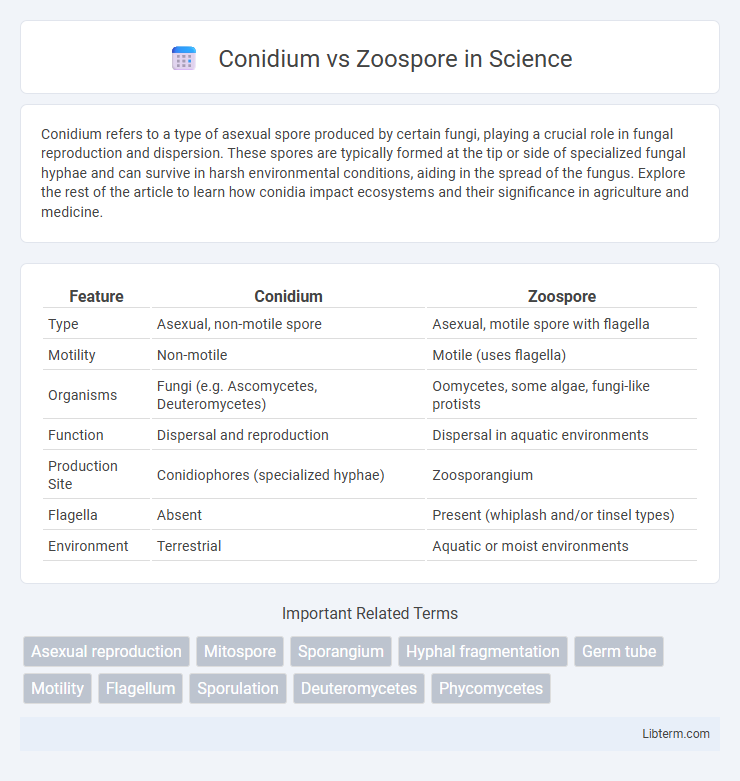Conidium refers to a type of asexual spore produced by certain fungi, playing a crucial role in fungal reproduction and dispersion. These spores are typically formed at the tip or side of specialized fungal hyphae and can survive in harsh environmental conditions, aiding in the spread of the fungus. Explore the rest of the article to learn how conidia impact ecosystems and their significance in agriculture and medicine.
Table of Comparison
| Feature | Conidium | Zoospore |
|---|---|---|
| Type | Asexual, non-motile spore | Asexual, motile spore with flagella |
| Motility | Non-motile | Motile (uses flagella) |
| Organisms | Fungi (e.g. Ascomycetes, Deuteromycetes) | Oomycetes, some algae, fungi-like protists |
| Function | Dispersal and reproduction | Dispersal in aquatic environments |
| Production Site | Conidiophores (specialized hyphae) | Zoosporangium |
| Flagella | Absent | Present (whiplash and/or tinsel types) |
| Environment | Terrestrial | Aquatic or moist environments |
Introduction to Conidium and Zoospore
Conidia and zoospores are distinct types of fungal spores with specialized functions in reproduction and dispersal. Conidia are asexual, non-motile spores formed externally on conidiophores, primarily facilitating airborne dispersal in fungi like Aspergillus and Penicillium. Zoospores are motile spores equipped with flagella, found in aquatic or moist environments, enabling active movement and infection in chytrids and oomycetes.
Definition of Conidium
Conidium is an asexual, non-motile spore produced by certain fungi commonly found in the phylum Ascomycota, formed at the tip or side of specialized hyphae called conidiophores. Unlike zoospores, which are motile spores equipped with flagella enabling movement in aquatic environments, conidia rely on air or other external forces for dispersal. The structural adaptation of conidia allows them to effectively propagate fungal species in terrestrial habitats without requiring water for mobility.
Definition of Zoospore
Zoospores are motile asexual spores equipped with one or more flagella, enabling them to swim in aquatic environments for dispersal and colonization. Unlike conidia, which are non-motile and typically formed on specialized hyphae, zoospores are produced within sporangia, allowing rapid spread in moist conditions. Zoospores play a crucial role in the life cycle of many algae, fungi, and protists by facilitating movement toward favorable habitats.
Structural Differences
Conidia are asexual, non-motile spores produced by fungi, characterized by thick cell walls and formed on specialized hyphae called conidiophores, allowing them to disperse through air. Zoospores are motile spores found in certain fungi and algae, equipped with one or more flagella for swimming in aquatic environments, and possess thinner cell walls to facilitate movement. Structurally, conidia lack flagella and are adapted for terrestrial dispersal, while zoospores have flagella and are adapted for dispersal in water.
Modes of Formation
Conidia form through asexual reproduction by budding or segmentation from specialized hyphae called conidiophores, resulting in non-motile spores adapted for dispersal in air. Zoospores develop within sporangia and are motile, equipped with flagella that enable movement in aquatic environments. The key distinction lies in conidia's formation as static spores suited for terrestrial spread, while zoospores emerge as motile spores designed for waterborne dispersal.
Mechanisms of Dispersal
Conidia disperse primarily through air currents, relying on dry, lightweight spores that detach easily from the fungal structure to travel long distances. Zoospores utilize water as their dispersal medium, swimming actively using flagella to navigate moist environments and infect host tissues. This fundamental difference in dispersal mechanisms reflects the adaptation of conidia to terrestrial habitats and zoospores to aquatic or highly humid conditions.
Ecological Roles
Conidia and zoospores serve distinct ecological roles in fungal dispersal and survival strategies. Conidia are asexual, non-motile spores that allow fungi like Aspergillus and Penicillium to colonize aerial and terrestrial habitats efficiently, contributing to decomposition and nutrient cycling. Zoospores, produced by aquatic fungi such as Chytridiomycota, are motile spores that enable colonization in aquatic environments by swimming through water, facilitating infection of amphibians and algae and influencing aquatic ecosystem dynamics.
Examples in Fungi and Algae
Conidia are asexual, non-motile spores primarily produced by fungi such as Aspergillus and Penicillium, serving as dispersal units in dry conditions. Zoospores are motile, flagellated spores found in certain fungi like Chytrids and in many algae groups such as green algae (Chlorophyta), enabling movement in aquatic environments. The key distinction lies in conidia's adaptation for airborne distribution, while zoospores rely on water for swimming toward favorable habitats.
Key Advantages and Limitations
Conidia are asexual, non-motile spores that offer advantages such as durability in harsh environments and efficient dispersal through air, enabling widespread colonization. Their limitation lies in the lack of motility, which restricts their ability to reach substrates in aquatic or unstable conditions. Zoospores, characterized by their flagella-driven motility, excel in aquatic environments by actively locating nutrient-rich sites but are limited by their sensitivity to desiccation and short lifespan outside moist habitats.
Summary Table: Conidium vs Zoospore
Conidium and zoospore differ primarily in their mode of reproduction and mobility; conidia are asexual, non-motile spores produced by fungi through mitosis, while zoospores are motile, flagellated spores capable of swimming in aquatic environments. Conidia serve as airborne or surface-dispersed propagules, aiding fungal spread without water, whereas zoospores require water for movement and infection. These distinctions are crucial for understanding fungal ecology, infection mechanisms, and environmental adaptation.
Conidium Infographic

 libterm.com
libterm.com